
Answers
1. Dilemma 1mk (Identification)
Warrior’s choices going to bring cows and risk being killed or stay and marry wonderful lovers and remain poor. 1mk ( Explanation)
- No mark if identification is missing.
2. Sang louder and louder (1mk)
- She ran and ran (1mk)
3. (ii) The warrior
- Brave (1mk) went for a lone raid (1mk)
(iii) the youngest lover
- loving (1mk) risked her life going to look for her lover (1mk)
(Any other correct trait and illustration) Total 4 mks
No mark if trait is missing.
4. (i) Expresses the girl’s love for the warrior (1mk)
(ii) Helped the girl trace her warrior lover (1mk) Total 2 mks
5. (i) The warrior was ready to die but instead he recovered (1mk)
(ii) Everybody thought the young woman and her lover were dead and insisted
their death rites be performed. (1mk) Any other relevant irony
6. (i) Pastoralists (½ ) – bull, cows (½ )
(ii) Hunting ½ - she killed a deer with lover’s spear ½ mks
7. (i) Opening formula
- to call for attention
- alert audience for start of narration
Removes the audience from the world of reality and takes them into the world of fiction
(ii) Closing formula
- to mark the end of the story.
8. A friend in need is a friend indeed
- the girl was willing to risk her life to serve her lover
marto answered the question on March 21, 2019 at 07:49
-
Read the narrative below and answer the questions that follow.
(Solved)
Read the narrative below and answer the questions that follow.
THE CRUEL STEP – MOTHER
Once upon a time, there was a man and wife who had a baby girl. Unfortunately, the wife died and so, the man married again. He got another girl with the second wife.
The two girls became extremely close, so close that whenever the mother sent one on an errand, the other was sure to accompany her. The mother, however, did not like the child of the deceased. She would always show her dislike by denying her certain favours. Her feelings became so bad that she decided to get rid of the girl. To do this, she dug a hole in her bedroom on a day when the husband was absent and covered the hole with a cow’s hide. She then called her daughter and sent her to the house of a friend some kilometers away. As usual, the two girls wanted to go together but the woman refused, giving the excuse that she wanted to send the other one elsewhere.
After the departure of her daughter, she called the other girl and sent her for her snuffbox in the bedroom. Unaware of what lay ahead, the girl eagerly rushed into the room only to fall into a hole! The mother very quickly filled the hole with soil, completely disregarding the girl’s screams for help.
When the daughter came back, she merely assumed that the absence of her dear companion was justified. After hours of waiting, she, however, became impatient and questioned the mother.
‘Where is my sister?’ she asked.
‘But she followed you. As soon as she did what I wanted, she ran after you. Now stop bothering me,’ the mother retorted.
Time passed and the now anxious girl went round calling out the name of the other one, but all in vain. Alas…. She cried the whole night and the next day and refused to touch any food. The father helped in the search but to no avail.
After three days, the girl still cried and called the other one. She then heard a very weak voice responding in song:
Maalya Maalya
Maalya Maalya
Na mwenyu niwe mwai iiee malya,
Ekwinza muthiko iiee malya,
Wakwisa kunthika iiee malya
Wakwisa kunthika iiee malya
(Maalya Maalya
And your mother is the wise one iiee malya,
She dug a grave iiee malya,
For interring me in iiee malya.)
The girl dashed towards the direction of the voice, repeated her cries and again go the same response. She came to the conclusion that whoever was responding was definitely underground somewhere in the house. Immediately theThe husband then explained the truth of the matter and told his in-laws to take their daughter with them. They said that if that was what she had done to the girl, they couldn’t have such a monster in their house. The woman was disowned by all and chased away.
QUESTIONS
(a) To which audience and when can such a story be told? (2 mks)
(b) Explain three features of style employed in the narrative . (6 mks)
c) Contrast the character of the mother and her blood daughter. (4 mks)
(d) Explain two problems you are likely to encounter when collecting materials for such a genre. (4 mks)
(e) What does the author mean by the following sentences as used in the passage?
(i) 'When the daughter came back, she merely assumed that the absence of her dear companion was justified.' (1mk)
(ii) And your mother is the wise one iiee Malya. (1mk)
(f) What is the moral lesson of this narrative? (2mks)
Date posted:
March 21, 2019
.
Answers (1)
-
Read the following proverbs and answer the questions after each.
(Solved)
Read the following proverbs and answer the questions after each.
(a) No cleverest person ever saved his own head.
(i) Explain the meaning of the above proverb and give an example of a situation in which it could be used. (2mks)
(b) Authority is the tail of a water rat.
(i) What type of audience would be suitable for the above proverb and why? (3mks)
(ii) Identify and explain the image used in this proverb. (3mks)
(iii) Under what category would you place this proverb? (1mk)
c) Give four characteristics of proverbs
d) Give four functions of proverbs.
e) If you were to carry out field work to collect proverbs, cite three main problems you would encounter. f) Give two similarities between proverbs and oral narratives. (2mks)
Date posted:
March 21, 2019
.
Answers (1)
-
The the following piece of oral literature and answer the questions that follow.
(Solved)
The the following piece of oral literature and answer the questions that follow.
NJABALA
Once upon a time, a man and his wife had a daughter. The girl’s name was Njabala and she was stunningly beautiful. But she was badly brought up, that girl. She was spoilt. She did not want to do any work in the shamba or around the house. All through her childhood, it was her mother who cooked for her, washed and ironed her clothes for her, did everything for her. But Njabala’s beauty was beyond words.Anyway, Njabala grew up and was soon ready for marriage. She married a young man who took her to his home. But of course she couldn’t do any work. When the time came for her to go and work in the shamba, she didn’t know what to do. She put both her hands on her head and cried out:.
Mamma, mother-of-twins!
It’s you who used to spoil me
Come and dig.
Whereupon the skeleton of her mother, who had died, suddenly appeared. It took the hoe and started clearing the shamba as it sang:
Njabala, this is the way women dig,
Njabala!
Njabala, this is the way women dig,
Njabala!
Don’t let me be caught by my in-laws.
And it cleared a large patch of the shamba, from here to way, way out there. Then it disappeared back to the grave. This went on for quite some time. Every time Njabala went to the shamba, she would call out:
Mamma, Mother-of-twins!
It’s you who used to spoil me
Come and dig.
Then the mother’s little skeleton would come and clear the shamba, singing;
Njabala, this is the way women dig,
Njabala!
Njabala, this is the way women dig,
Njabala!
Don’t let me caught by my in-laws.
One day, however, a relative of Njabala’s husband saw what was happening. She went and said to the husband. 'You know what? The food we eat in this house is grown by skeletons'.
The husband said, 'Oh dear, Oh dear!' The next day, he went and hid in the shamba. When Njabala arrived, she called out as usual.
Mamma, Mother-of-twins!
It’s you who used to spoil me
Come and dig.
The skeleton came and began to dig as it sang:
Njabala, this is the way women dig,
Njabala!
But suddenly, the man leapt out of his hiding and dealt his mother-in-law’s skeleton a big blow with his stick. The skeleton disappeared immediately. Njabala was almost fainting with shame and shock. Her husband said to her angrily, “So this is what’s been happening? You’ve been feeding us on food grown by skeletons?”
From that day on, Njabala learned to work saying, “What else can I do now that my mother has been beaten and driven away?” And so she became a hard-working woman.
I left her happy with her husband and the rich crop she was harvesting from her shamba, and I came back here. That is what I saw.
i) Which audience would this narrative be most appropriate for? Justify your answer. 2mks
ii) State and explain three functions of song as an aspect of style in this narrative. 6mks
iii) Apart from the song, identify three typical features of oral narratives evident in this narrative. 6mks
iv) Using at least two expressions from the narrative, show evidence that the recorder remained true to live performance of the narrative. 4mks
v) Cite and explain a proverb from any community you are familiar with that comments on either beauty or work
Date posted:
March 21, 2019
.
Answers (1)
-
Read the following oral poem and answer the questions that follow
(Solved)
Read the following oral poem and answer the questions that follow
The Timi of Ede.
Huge fellow whose body fills an anthill
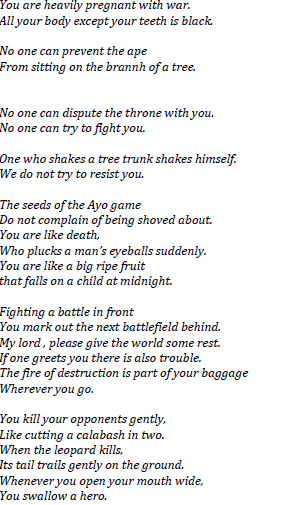
(Source: Ulli Beier(ed), African Poetry, Cambridge University Press, 1966)
(a) Classify the above poem. 1 mk
(b) What images does the poet use to build up the character of Timi? 6 mks
(c) What is the attitude of the speaker towards Timi? 2 mks
(d) Identify the themes of the poem. 4 mks
(e) Describe the mood of the poem. 2 mks
(f) Mention any three aspects of performance that can be lost if this song is written down. 3 mks
(g) State any four functions of this song. 2 mks
Date posted:
March 21, 2019
.
Answers (1)
-
Read the poem below and then answer the questions that follow.
(Solved)
Read the poem below and then answer the questions that follow.
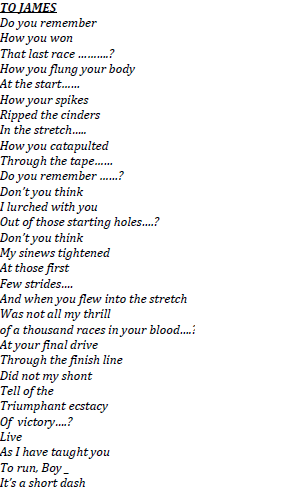
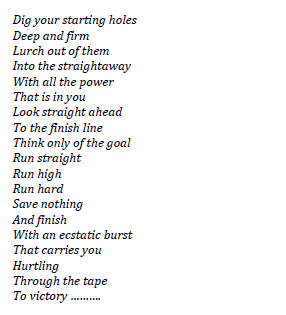
a) What event is the speaker describing? Illustrate. (2 mks)
b) Explain how the person gets involved in the event he describes. (4 mks)
c) What is the relationship the persona and the ‘you’? Illustrate. (4 mks)
d) Identify and illustrate any 2 stylistic features in this poem. 4 mks)
e) Explain ‘you catapulted’ 1mk
Date posted:
March 21, 2019
.
Answers (1)
-
Read the following poem and answer the questions that follow.
(Solved)
Read the following poem and answer the questions that follow.
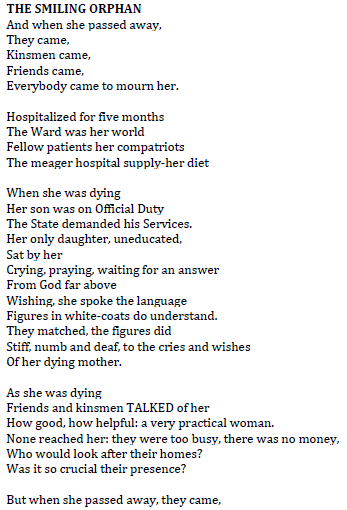
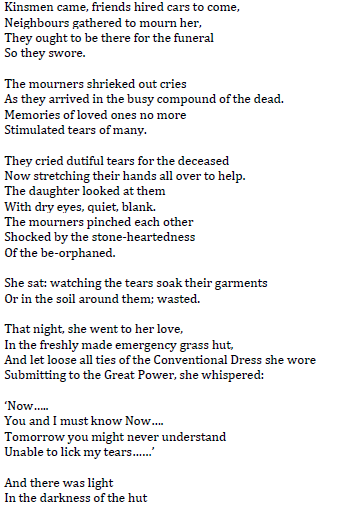
While outside
The mourners cried
Louder than the Orphan.
By Grace Birabwa Isharaza.
1. What is the poem about? (3mks)
2. Comment on the title of the poem. (2mks)
3. What is the attitude of the persona towards the mourners? Explain your answer.(4mks) 4. Paraphrase the message in the fourth stanza. (3mks)
5. Explain the following lines as used in the poem (2mks)
(i) They cried dutiful tears for the deceased.
(ii) And there was Light in the darkness of the hut
6 Comment on the tone of the poem (2mks)
7. Identify and illustrate two stylistic devices used in the poem. (4mks)
Date posted:
March 21, 2019
.
Answers (1)
-
Read the poem and answer the questions which follow.
(Solved)
Read the poem and answer the questions which follow.
THE MARKET WOMAN
The market woman
Strong sun
and the market woman in the shade
of the mulemba
- Orange, my lady
a nice little orange!
Light plays in the town
its burning game
of brightness and shade
and life plays
in worried hearts
its game of blind-man’s buff.
The market woman
who sells fruit
sells herself.
- My Lady
orange, nice little orange!
Buy sweets oranges
buy from me too the bitterness
of this torture
of life without life
buy from me the childhood of the spirit
this rosebud
that did not open
start still impelled to a beginning.
Orange, my lady!
I exhausted the smiles
with which I cried
I no longer cry.
And there goes my hopes
as did the blood of my children
mingled with the dust of roads
buried on plantations
and my sweat
soaked in the cotton threads.
As effort was offered to
the security of machines
the beauty of tarmac roads
of tall buildings
comfort or ricy gentlemen
happiness dispersed in towns
and I
became a part
of the very problems of existence.
There go the oranges
as I offered myself to alcohol
to anaesthetize myself
and stupefied myself to live.
I gave all.
Even my pain
and the poetry of my naked breasts
I gave to the poets.
Now I myself am selling me
Buy oranges!
my lady!
Take me to the markets of life
My price is only one: - Blood.
Perhaps selling myself
I posses my self
- Buy oranges!
From Scared Hope by Agostino Neto,
Tanzania Publishing House, 1974, 12 - 14
QUESTIONS
(a)Identify the three voices in this poem. 3mks
(b) What is the Poet’s attitude to the market woman? 2mks
(c)What is the theme of the poem? 3mks
d) Describe the feeling of the market woman. 3mks
e) Identify the lines spoken by the persona in his role as an observer. 3mks
f) Explain the meaning of the following lines. 6mks
(i) I exhausted the similes
With which I cried
I no longer cry
(ii) Even my pain
and the poetry of my naked breasts
I gave to the poets
……………………………………………………………………………………………My price is only one: - Blood
Date posted:
March 21, 2019
.
Answers (1)
-
Define the term attitude in poetry.
(Solved)
Define the term attitude in poetry.
Date posted:
March 21, 2019
.
Answers (1)
-
Discuss the distinctive features of wole Soyinka's poems ..I think it rains.. Night.. In respect to modern African poetry.
(Solved)
Discuss the distinctive features of wole Soyinka's poems ..I think it rains.. Night.. In respect to modern African poetry.
Date posted:
March 12, 2019
.
Answers (1)
-
Write an essay to show how rhetorical questions have been used in the Blossoms of Savannah
(Solved)
Write an essay to show how rhetorical questions have been used in the Blossoms of Savannah.
Date posted:
February 3, 2019
.
Answers (1)
-
Identify all the morphemes in the following sentence and classify them according to types. In schools, we usually use English while communicating with our teachers and...
(Solved)
Identify all the morphemes in the following sentence and classify them according to types.
In schools, we usually use English while communicating with our teachers and friends.
Date posted:
December 6, 2018
.
Answers (1)
-
What are dirges.
(Solved)
a)What are dirges.
Date posted:
October 16, 2018
.
Answers (1)
-
Read the following excerpt and answer the questions that follow “My sister Vera and I have had differences, but I have no doubt....
(Solved)
Read the following excerpt and answer the questions that follow
“My sister Vera and I have had differences, but I have no doubt that she would have made an excellent mother - much than I ever was. The children love her. So it is with confidence that I leave every aspect of their care in her capable hands with
the assistance of whichever family members she chooses for I appreciate that the nature of her calling may not allow her to
establish her own home. I want her to know that I love my children though my way of expressing it may not have satisfied
her. I expressed it by making sure that they will never lack in the things I believe in. it is true that money cannot buy
happiness or I would have been happy; buy it can buy pretty well everything else. OK, it cannot buy life either - for I am
dying and will die in the slowest most painful way possible, but I am not sorry for the way I have lived; for I found out
however late, that everything, everything has a price. This is the price of living the way I have lived. So be it; I will pay it”
Vera wept afresh when the will was read out. What could make anyone so bitter? They had had good loving parents and all
her brothers and her other sister were happy warm-hearted people with ordinary faults, but not with such bitterness - the
bitterness of gall - and that in someone so beautiful! She had been only thirty- three and until the last six months of her illness
she had still been the loveliest person Vera had ever seen.
Questions
1. Place this excerpt in its immediate context. (4mks)
2. What is Becky?s attitude towards the life she lived according to the excerpt? (3mks)
3. From your knowledge of the text, who are Becky?s children referred to in the excerpt? (2mks)
4. State and illustrate the character trait of:
· Becky (2mks)
· Vera (2mks)
5. Identify and illustrate two stylistic devices used in the excerpt (4mks)
6. State and illustrate two thematic concerns brought out in the excerpt (4mks)
7. From your knowledge of novel, write in note form three things that Becky believed in. (3mks)
8. Rewrite the following sentence according to the instructions given, (l mk)
Vera wept afresh when the will was read out (Add a question tag)
Date posted:
October 3, 2018
.
Answers (1)
-
Discuss how contemporary social media forms such as Viusasa and YouTube have transformed oral literature in Kenya.
(Solved)
Discuss how contemporary social media forms such as Viusasa and YouTube have transformed oral literature in Kenya.
Date posted:
August 17, 2018
.
Answers (1)
-
State main features common to all short forms
(Solved)
State main features common to all short forms
Date posted:
August 13, 2018
.
Answers (1)
-
Techniques you can employ in narrating a trickster story to an audience
(Solved)
Techniques you can employ in narrating a trickster story to an audience
Date posted:
July 31, 2018
.
Answers (1)
-
THE TEARS OF A SLAVE
Adieu, to my native shore,
To toss on the boisterous wave;
To enjoy my kindred no more,
But to weep – the tears...
(Solved)
THE TEARS OF A SLAVE
Adieu, to my native shore,
To toss on the boisterous wave;
To enjoy my kindred no more,
But to weep – the tears of a SLAVE!
By the sons of freemen I’m borne,
To the land of the free and the brave;
From my wife and children I’m torn,
To weep – the tears of a SLAVE!
When, I think on mother and friends,
And the joy their countenance gave;
Ah! How my sad bosom it rends,
While weeping – the tears of a SLAVE!
Ah! Now, I must labour for gold,
To pamper the pride of the knave;
Ah! Now, I am shackled and sold
To weep – the tears of a SLAVE!
Keen sorrow so presses my heart,
That often I sigh for my grave;
While feeling the lash-cruel smart!
And weeping – the tears of a SLAVE!
Ye sons, of the free and wise,
Your tender compassion I crave;
Alas! can your bosoms despise
The pitiful tears of a SLAVE!
Can a land of Christians so pure!
Let demons of slavery rave!
Can the angel of mercy endure,
The pitiless – tears of a SLAVE!
Just heaven, to thee I appeal;
Hast thou not the power to save?
In mercy the power reveal,
Questions.
1. Who is the persona in the poem? (2mks)
2. What is happening to the persona in the first stanza? (3 marks)
3. Identify the dominant two styles used in the poem and state their effectiveness? (4mks)
4. What is the tone of the poem? (2mks)
5. Who do you think is described as ‘knave’ in the fourth stanza? Give a reason for your answer. (2mks)
6. In what way does the persona question religion? (2mks)
7. What solution does the poet offer that will end slavery? (2mks)
8. Explain the meaning of the following lines as used in the poem. (3mks)
a. From my wife and children I’m torn.
b. Keen sorrow so presses my heart.
Date posted:
July 25, 2018
.
Answers (1)
-
Discuss information technology as a tool for communication
(Solved)
Discuss information technology as a tool for communication.
Date posted:
July 25, 2018
.
Answers (1)
-
Show how proverbs have been used in betrayal in the city?
(Solved)
Show how proverbs have been used in betrayal in the city?
Date posted:
June 24, 2018
.
Answers (1)
-
Explain the character traits of Ole Kaelo, Taiyo and Resian in the novel Blossoms of the Savannah
(Solved)
Explain the character traits of Ole Kaelo, Taiyo and Resian in the novel Blossoms of the Savannah.
Date posted:
June 22, 2018
.
Answers (1)